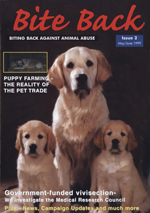The Archives
-
Periodicals
Bite Back (U.K.) #1&2
04.07.15 | PermalinkBite Back – Issues 1-2 (1999, Bristol, England)
One of at least four publications to share the same moniker, this version of Bite Back came into being at the turn of the century. Glossy, full magazine sized, and free, Bite Back was a wonderful tool for reporting on the exciting campaigns of its era. Anyone interested in pressure campaigning will enjoy the brief articles, updates, and images from Hillgrove, Shamrock, Regal Rabbits, and Huntingdon Death Sciences.
We have very little information about this publication and do not know if there were subsequent issues. If you have more information please contact us HERE.
…
-
One-off publications
SHAC – A Campaign That Made History
11.28.13 | PermalinkSHAC – A Campaign That Made History (2013 – Italy)
I am happy to see that new generations of activists are discussing the successes and failures of the Stop Huntingdon Animal Cruelty campaign with an eye towards applying those lesson to the ongoing struggle for animal liberation. This attractive booklet was originally released in Italy under the name “SHAC: ha fatto storia” and focuses on the legal repression, past and present, experienced by those working to close Huntingdon Life Sciences. The english translation is not perfect, but makes for a good overview of the FBI’s “Operation Trailmix” in the US and INTERPOL’s “Operation Achilles” in Europe.
The collective that made this booklet has a blog at shacmadehistory.noblogs.org. I would love to see them continue to dissect the international repression against SHAC and also support the victims of the same.
…
-
Most Popular, No Compromise, Periodicals
No Compromise: The Final Two Issues
05.13.13 | PermalinkNo Compromise #29-30 (2006. Santa Cruz / San Francisco, CA)
The early days of my activism were so exciting. After a lifetime of feeling powerless I suddenly discovered that there was a community dedicated to fighting the good fight. Its members were in every major city and many smaller ones, and sometimes not living in any city at all, but in trees and encampments. The people involved were empowered to act for themselves in order to create a better world, and had abandoned all the false hope of political parties and their dead politics. Words meant little, action was what counted, and the sky was the limit. The internet was not yet in wide use, and thank goodness! That meant that we met each other in conference rooms, in squats, on the streets, and sometimes on the pages of No Compromise magazine.
No Compromise shaped who I am today. Each new issue contained articles that helped me and thousands of others to evolve our own style of resistance, and as our experience grew we were able to share our stories in the pages of the magazine.
After 30 issues, the steering committee of No Compromise decided to stop publishing in 2006. Their decision could not have come at a worse time. With the SHAC website and newsletter killed by the convictions of the SHAC 7, Bite Back being published only sporadically and with a limited focus, and the Earth First! Journal mired in its “Confronting Oppression Within” drama, the sudden absence of No Compromise meant that the primary sources for radical animal liberation news, opinion, and strategy were the twin sewers of online social networks and the North American Animal Liberation Press Office. These were dark times for our movement, and we are only just beginning to recover.
The final issues of No Compromise were the best of the series, though! I was in prison when issue 30 was released, and it felt electric in my hands. I read it over and over, alternately laughing and crying. As I was putting this post together I decided to pull out that print copy. It gave me the same sense of awe I had when I read those first issues. More than that, it reminded me that there is still a community of people capable of changing the world through compassionate direct action and mutual aid. And you know what? We are going to win!
KEEP FIGHTING,
Josh Harper(The complete set of all past issues of No Compromise can be found HERE)
…
-
No Compromise, Periodicals
No Compromise #23-26
02.17.13 | PermalinkNo Compromise 23-26 (2004, Santa Cruz / San Francisco, CA)
One of the lessons that archiving old animal liberation publications has taught me is that the most extreme actions have rarely produced much in the way of results for animals. A public that already sees veganism as odd might still see the value of rescuing animals from a laboratory, but will never support a car bombing. When innocents are injured, or when murder was the goal, the backlash starts to creep into our own ranks, and as we fracture law enforcement and industry groups take advantage. In the end, I can think of no bombing (or contamination, or grave robbing, etc.) which advanced the cause of animal rights more than it harmed it. This is not to say that bombings and the like could never be successful. At later stages of many revolutionary struggles, when the majority of the public supports the cause, bombs can clear away in one night what years of protest could not. While a movement is in its infancy, however, it could be argued that more often than not bombs blow up in our faces.
And so it was in 2004 when a group calling itself the Revolutionary Cells Animal Liberation Brigade carried out two bombings of HLS related targets in California. The movement was left to make lemonade from truly shitty lemons, and No Compromise did their best to mitigate the harm of the actions while keeping activists focused on the real enemy.
The year continued with the indictment of the SHAC 7, the emergence of Austria as a leader in the movement, and some exciting open rescues. Sarahjane Blum and Ryan Shapiro’s organization, GourmetCruelty.com, carried out one such operation that piqued public interest and eventually resulted in a sympathetic program on Animal Planet. Elsewhere Gina Lynn was imprisoned for defying the Seattle grand jury, Billy Cottrell was arrested for a massive SUV dealership arson, and the Universtiy of Iowa was treated to the most sophisticated lab raid to occur since the early 90s.
Every time we post a year of No Compromise we say the same thing: that this is essential reading for those who wish to understand the recent history of our movement. This posting is no exception. No Compromise was the best AR publication of its era, and 2004 saw the publication refining its strengths and providing their readers with four of the best issues yet.
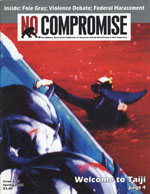



-
No Compromise, Periodicals
No Compromise #20-22
11.15.12 | PermalinkNo Compromise #20-22 (2003. Santa Cruz / San Francisco, CA)
No Comp scored another great year in 2003, this time by going deeper into practical instructions for campaigning, and also by examining the smaller stories in greater detail. While the high profile victories of anti-HLS activists were given their due, inspirational figures who had passed on were also given touching coverage. Issue #20 features articles on early Band of Mercy and Animal Liberation Front founder Sue Smith, and Sweden’s animal lib die-hard, Ake Soderlund. Similar examinations of our past, and the courageous figures whose shoulders we stand upon, pepper the 2003 issues. Of particular note is the article on Henry Hutto in issue #21.
2003 was also the year that Rod Coronado finally got off of probation and was allowed to participate in the movement again. His writings for No Compromise were as subversive and inspiring as ever, and it is easy to see why the government considered him such a threat.
As the year progressed No Comp moved to a magazine format and tightened their graphic design skills in response to Jake Conroy’s work on the SHAC USA newsletter. These glossy issues were excellent contributions to the movement, and it is a shame that in only a few more years NC would cease to exist altogether. These information (and inspiration!) packed issues are worth reading again to inform and encourage our current actions.


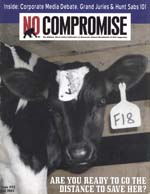
-
Campaign newsletters, Most Popular
More SHAC USA newsletters
09.22.12 | PermalinkSHAC USA Volume 2, issues 2 and 4 (2002, Philadelphia, PA)
It is hard to describe the feeling of constant elation that I had working on the campaign against Huntingdon Life Sciences. After years of grassroots organizing it seemed that the movement was finally moving forward with speed and determination. News constantly poured in from all corners of the globe that a new target had been chosen- and eliminated. Everyone participating was energized, hopeful, and on the attack.
One of the reasons that so many people were inspired to take action against HLS was the SHAC USA newsletter. Each issue featured the groundbreaking graphic design work of Jake Conroy. His layouts and other artistry made each copy a pleasure to behold, and also left other organizations scrambling to improve the designs of their own publications. If you doubt that a periodical could prompt someone to pickup a sign, bullhorn, or brick, than you feel very different than the US Government. They were so threatened by Conroy’s print and web work that he was indicted in the SHAC 7 case, and received one of the longest sentences of all of the defendants.
These two issues of the newsletter date from 2002, which was an exciting time in the campaign. After Stephens Inc. had capitulated, thousands of people suddenly had faith that they could, in fact, change the world. We all knew that we were a part of something special, and I think that comes across in the text and imagery of of these two movement gems. Sure, we were cocky, our rhetoric sometimes went too far, and we weren’t always as organized or prepared as we claimed- but we walked our talk to the best of our ability and our efforts took the movement far.
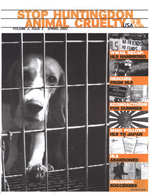

-
Most Popular, Periodicals, Videos
SHAC Revisited
07.02.12 | PermalinkSHAC USA Newsletters, Various Issues (2001-2006, Philadelphia, PA)
Diaries From Hell (2001, Princeton Junction, New Jersey)
The Mandate & Strike Back – Shac Videos (2002, Philadelphia, PA)Today marks the end of a very long journey for me. After more than two years on pre-trial release, eight months on house arrest, three years in prison, and three years on probation, my life is now my own again. As of this morning I no longer need to fill out monthly reports, open my home to law enforcement at any time without probable cause, give the government constant access to my e-mail and social media accounts, or stay confined within the western district of Washington. Best of all, I can return to the kind of organizing that I love and live the life of conscience that I committed myself to so many years ago.
The people who took away my freedom did not do so because I was breaking the law. In fact, they knew that I was not doing so. FBI documents show that I was under almost constant surveillance for years of my life. One field office after another followed me in an attempt to prove that I was “the nexus of illegal [animal and earth liberation related] crime in the Northwest.” They hired informants to befriend me, went through my garbage, paid off my mail carrier to write down the return addresses of my incoming mail, attempted to entrap me, raided my home… the list could go on and on. In the end they had some tapes of lectures I gave advocating forms of hacktivism, and for that speech activity I had my life interrupted for the better part of a decade. An appeals court later said this about my conviction: “Harper’s personal conduct does not cross the line of illegality; to punish him simply on the basis of his political speeches would run afoul of the constitution.” They then went on to uphold my conviction.
If all of the years stolen from me were not about crimes I had committed, what was the government’s motivation? The answer to that question is complex, but I believe the primary concern for the ruling class was that I had begun to see through their illusions of status and power. I know how grandiose- even absurd- that may sound, but please bear with me for just a moment. I was born to working class parents so poor that my first crib was made from a dresser drawer. My mother worked in convenience stores, cleaned homes, and toiled away her health in a frozen foods warehouse. My father was a Vietnam veteran who had survived a fire in the tank he was driving. The horror that he experienced in our government’s imperialist venture in south-east Asia colored every moment of our home life. He returned from his time in the army addicted to drugs, disabled, and in constant pain from shrapnel that was still lodged in his skull. He worked off and on as a mechanic and small time drug dealer. This is the situation that I was raised in, but I am not complaining. My parents loved me and my sister, and despite their mistakes they did their best to help me become a good person. My dad once saw two cops harassing a homeless man outside of a 7-11. They kept asking him if he was “an illegal” and made several references to his race, repeatedly calling him “amigo.” Everyone sat in their cars and watched. Everyone except for my dad, who got out and challenged the police. That moment taught me more than any private school or university ever could have. And while my mom couldn’t always afford the clothing that I selfishly demanded when I was kid, she never bowed down to anyone higher on the social ladder. When some entitled rich kid gave her shit at work, she gave it right back and then some. My heart swells with pride when I think about the warning she got from her bosses at one job: she was required to provide service to police officers and had better begin doing so or else she would be fired. After years of seeing the cops in Eugene, OR beat and harass the underclass she wouldn’t sell them coffee and doughnuts, and continued in her disobedience even when her job was on the line.
I always knew that no matter what my economic status was, that my life was just as valuable as that of a billionaire or a president. I do not care about their titles or money or connections, but I began to care an awful lot about their abuses of power. The wealthy elite, who strip this planet of its life support system, who benefit from racism, sexism, and homophobia, who view our non-human kin as machines for profit, who turn the masses against each other, are made of flesh and blood just like you and I. They want us to believe in corporate personhood because it distracts from the man behind the curtain, the vulnerable decision makers who use towers of steel and concrete to appear more powerful.
This was the threat of Stop Huntingdon Animal Cruelty; we saw through all of the social conditioning that tells us that we are too weak to effect change. We went straight to the homes of those in power, challenged them on their golf courses, screamed at them while they vacationed at summer homes. We were the barbarians at the gate, an alliance of the kind of people who did not usually get heard by the mega-rich of the world. Tooth and nail we went after their profits, and along the way refused to divide and fracture over broken windows or graffiti. Everyone was welcome if they would fight, and I smile so big it hurts when I think of the grandmothers, the punks, the students, and all the other unlikely comrades who marched together in defiance of the false hierarchy that tells us to keep separate and leave the rich to their own devices. We didn’t stay in our place. In fact, we recognized that our place was wherever the hell we chose, and the world of finance and animal abuse was rocked as a result.
This isn’t to say that we were perfect. We made so many mistakes, and we must be accountable for them. As Conflict Gypsy completes its archives of Huntingdon Life Sciences campaign materials we will be critical of the movement’s failures. But today, as I leave Washington to see my family and friends and celebrate my new freedoms, I hope that the spirit of the campaign will infect you. All of us have a revolutionary spark in our hearts, and together these individual sparks provide a beautiful warmth that melts away the cold sterility created by our rulers. Together we can turn the tide of ecocide, of prejudice, of economic and political exploitation. Never, ever believe otherwise.
For animal liberation, for global revolution, and for joy! Yours always,
Josh Harper
July 2nd, 2012




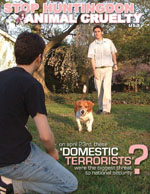

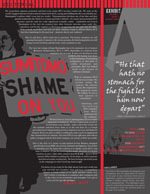


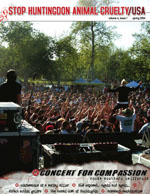




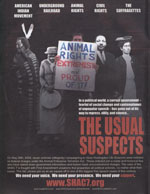


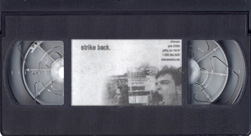
…
-
No Compromise, Periodicals
No Compromise #12-14
05.15.12 | PermalinkNo Compromise #12-14 (1999, Old Bridge, NJ and Santa Cruz, CA)
If I had to create a list of my favorite years in animal and earth liberation history, 1999 would be in the top 5. As the movement looked towards the new millennium there seemed to be an intense urgency in the air, perhaps people felt the need to close the 20th century with a bang or leave their mark before the world ended in a technological melt down on Y2K! Whatever the reasons, direct action reached a fever pitch. Lab raids returned to the United States, the Earth Liberation Front continued it’s ascendancy, Hillgrove farm was shut forever, and everyone seemed to be preparing for the World Trade Organization ministerial in Seattle. Across the globe there was a sense that people were not going to take it anymore, and whether you were struggling against bio-technology or prisons or speciesism, chances are good that you were employing some form of illegal tactic.
No Compromise may not have covered everything going on in the global struggle, but if it was animal lib related then chances are it was covered in these three issues. From the death of Alex Slack to end of the annual Hegins pigeon massacre, you’d be hard pressed to find a more complete overview of these twelve action packed months.
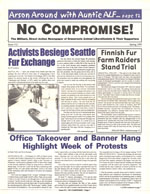
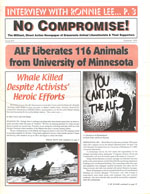
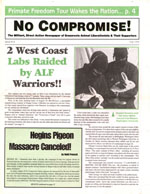
-
One-off publications
Inside / Out: Diary of Madness
05.08.12 | PermalinkInside / Out: Diary of Madness (2001, St. Louis, MO)
Back when the United States still had a strong grassroots animal liberation infrastructure, activists would regularly travel from all across the country to attend national demonstrations. Hundreds, or even thousands, of people would descend on various targets, and for a few days at least, bring the killers a little taste of the hell that they regularly created for non-humans.
Inside / Out is the story of Brenda Shoss’ experience at one such demonstration which took place in Little Rock between October 27th and 29th in 2001. Brenda, a devoted animal rescuer and mother, represented the broad diversity of the campaign against Huntingdon Life Sciences during it’s early years. Hailing from St. Louis, she hardly fit the image of “the usual suspects” in militant campaigning. Happily marching alongside pierced punks and anarchists, Brenda’s mild mannered and patriotic politics did not clash with those held by her comrades: instead her presence signaled a movement able to break through to a wider audience. Throughout her account of the demonstrations she evokes the anger and outrage that prompted thousands to band together, despite their differences, to fight to shut down HLS.
Following her personal reflections on the demonstration and overall campaign are excerpts from Michelle Rokke’s “Diaries of Despair,” an insider’s account of the horrors that happen behind the locked doors of Huntingdon, a company that continues to kill hundreds of animals a day in unnecessary and vicious experiments.
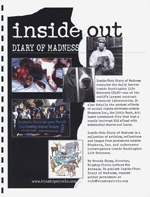
-
Periodicals, Underground
Underground #14-15
06.21.11 | PermalinkUnderground 14-15 (1999, Ontario, Canada)
The turn of the century was an odd time in the world of radical politics. The remnants of the mid-90s militants grassroots were fading away, and those still loyal began to look to England for signs of hope. In Eugene, an odd coalition of old school forest activists, crusties, anarchists, and even some members of the old left were rapidly embracing a philosophy critical of civilization, leftism, and pacifism. People all over the globe were beginning to talk about the specter of global trade agreements, and everyone began planning for the World Trade Organization meetings in the northwest, where arsons, lab raids, and whale hunt sabotages were already rampant. Everywhere there was a sense that the old politics were dying, and that something new was right around the corner.
Underground reflected some of this feeling, but production delays, staff turnover, and the rapid loss of its old writers meant that only 2 short issues were produced this year. Some great history was documented in these pages, but sadly much was left uncovered. These two issues should be thought of as an incomplete sampling of just some of what ’99 brought the world.
Also see Underground 1-3 and Underground 4-6 and Underground 7-9 and Underground 10-13 and the final rare issue, Underground 16.


…

